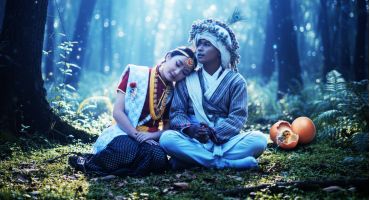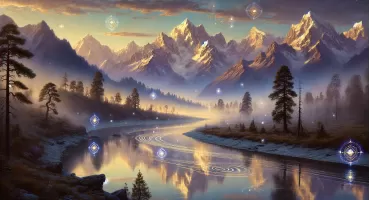Long, long ago, Paruhang, the king of the skies, was teaching Sumnima, the mother -earth manifest, the Mundhum. The teachings were so vast, so endless, that day slowly dissolved into night. Paruhang continued reciting the sacred knowledge, but Sumnima eventually drifted into sleep. Paruhang did not notice her quiet breathing or her stillness. He kept speaking, with words flowing like an unbroken river.
Nearby, a jungle fowl had laid its eggs. Through the sheer force of Paruhang’s recitation, the power of the Mundhum seeped into the forest. By the time night passed, the eggs had already hatched. At dawn, the tiny chick had grown into a full jungle fowl, standing alert and wide-eyed, listening to the Mundhum with little sounds of agreement — “anh, anh, yes, yes.”
When Paruhang finally turned and saw the bird eavesdropping, he tried to catch it. But the rooster darted away in a flash, beating its wings and escaping into the trees.
Paruhang watched it from a distance and declared:
“My descendants will ensure that the power of the Mundhum, one day, must return from you back to me.”
— told to me by Late Ramesh Tenchipa, Kalimpong, 2016
Oral stories, as I have come to understand them, hold fascinating details, carefully hidden. The ancestors who created these stories were likely seeking to transmit important teachings. Without the means to record their wisdom in writing, they incorporated their philosophy, rituals, traditions, and understanding of the world into these narratives. While these stories may have evolved over time, their essential core remained intact. Across generations, some regarded these stories as history, others dismissed them as trivial, and yet others classified them as mythology. Regardless, the stories continued to be passed down because they were compelling. But eventually, a few descendants would listen closely, interpret the layers of meaning, and uncover the treasure of knowledge that the ancestors had left behind through these stories.
Long before I ever opened an anthropology book or learned to speak about “narrative epistemologies,” I learned to listen. Not the passive listening we perform in classrooms or on recordings, but the deep, alert listening that requires the entire body. Listening to elders in the winter sun, listening to stories while wood cracked in the fire, listening to the world as though meaning was something carried in spoken verses. Sometimes it took some Charima Waasim (millet beer) to make the elders talk! But when they did, I listened. It was a sophisticated architecture of memory, and knowledge that lived outside of writing. Only later did I understand that the discipline of anthropology had long been making this same point. Societies without written texts do not lack knowledge; they just transmit it differently.
Anthropologists have argued for decades that in oral cultures, like the ones in the Himalayas, knowledge must be renewed through performance. Jack Goody captured this when he wrote, “Every performance is also a creative act and there is no distinct separation between performer and creator.” (Goody, 1998, Memory in Oral Tradition). I didn’t fully grasp what he meant until I began witnessing Tamang rituals where the Tamba walked along the line between narration and action. A story was never simply told. It was enacted, sung, danced, embodied. Even in the absence of a song or dance, it was an animated sequence with dialogues and more often, humor.
Over time, I began to see how oral traditions were not fragile, vanishing things. They were adaptive systems. It was fluid enough to survive political turbulence, migration, external influence, and generational change. A young person might not remember a specific genealogical detail, but they would know the melody of a lamentation, the ritual beat of a Rama Ken or Damphu, the gestures of a ritual dance. These became the axis of cultural identity at moments when written history remained silent.
What struck me most was how oral traditions carried stories that were also theories about life. Among Himalayan communities, a narrative was a way of interpreting drought, illness, misfortune, or conflict. A single origin story might contain ecological wisdom and genealogical knowledge simultaneously. I understood, then, why elders told me that the tiger or bear were ancestors and a bamboo a sibling, or that a cave or hilltop, like Khokwalung, Tuwachung, or Halesi, were sacred because a story had happened there. As Keith Basso observed, “Knowledge of places is closely linked to knowledge of the self, to grasping one’s position in the larger scheme of things, including one’s own community … and to securing a confident sense of who one is as a person” (Basso 1996, Wisdom sits in Places) The more time I spent time listening and traveling, the more I realized that the landscape itself was the archive and the stories were the tools to read it.
What makes oral traditions especially powerful is that they do not freeze meaning. Every telling becomes an interpretation, a way of calibrating the past to the present. People in Darjeeling believe that everyone tells the same story differently and some have even told me that if a story is told exactly the same way each time, it dies. The vitality of the narrative comes from its ability to travel through time. Oral tradition is dynamic because life is dynamic. It moves with people as they migrate, absorb new ideas, change occupations, or reconfigure their social worlds.
In my early years of research, I was troubled by the fact that oral accounts often diverged. I couldn’t understand why the Thulung and the Bantawa had different characters for the same plot. Why were the endings in the stories of Kham Magar different from the Thapa Magar. Two villages separated by a three-hour walk might tell the same origin myth in completely different ways. At first, I tried to determine which version was “correct.” Slowly, I realized that this question made little sense. In an oral culture, accuracy is not measured by fidelity to an original text. Every story has to resonate with a lived experience. A story that fits the social, ecological, linguistic, or moral landscape of a community becomes “true” in its own right.
Oral traditions do something that written texts often cannot. They transmit affect. The sound of a grandmother clearing her throat before the first line of a story, the beat of a description shaped by her breath, the pauses and silences that carry emotional weight; these elements form a sensory field that writing rarely captures. To listen to a story is to feel time differently. Moments stretch, shrink, or fold. The past stands beside you, as if leaning in.
The preservation of oral traditions, then, is not simply a matter of recording them. It is an issue of keeping the relationships alive. As soon as a story becomes something that only lives inside a file or a transcript, it begins to lose the social conditions that made it meaningful. Even the most careful documentation cannot replicate the tone of an elder’s voice or the weight of a ritual moment. Moreover, I believe that stories are to be told, not written, no matter how far the written word may reach.
Today, each generation reshapes the narrative world to express its own concerns. Young people incorporate migration experiences and modern complexities into ancestral tales. They keep the story alive by letting it evolve. In our quest for preservation, we must stay generous enough to let these traditions breathe and modify itself. Oral tradition is a method of thinking. It teaches people how to remember, how to interpret, how to adapt, and how to remain secured in the midst of change.
This realization has transformed the way I see modernity. We often assume that progress belongs to literacy and technology, and oral traditions only evoke a fictional world. I believe in the opposite and that oral forms of knowledge are still relevant. They still offer continuity where institutions fail. Even now, when I return to my ancestral home or sit with elders under the same sky, I am reminded that oral traditions are living, breathing infrastructures of community life. They hold cosmology, ethics, ecology, and emotion in a single narrative. And they remind us that knowledge can be carried in speech just as powerfully as it can be stored in books.
Ultimately, these stories do much more than entertain or explain. They preserve language and identity. Through them, words obtain power as they transmit speech from one generation to another. Through these stories, communities remember their values, and the relationships with ancestors, land, spirits and each other. They provide a framework for understanding themselves. These narratives that begin simply with “Uhile Uhile” and “Eka deshma”, become maps for moral and social navigation, and a mirror reflecting shared history and culture. Without these stories and without the living practice of telling and listening, we would certainly lose knowledge and also the strands that connect us to ourselves and to each other. And we might never comprehend the invaluable wisdom that our ancestors tried to pass on.





Leave a Reply